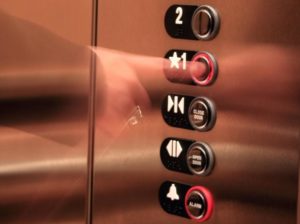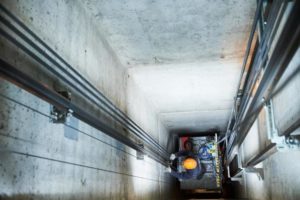Engineering Ups and Downs
This lesson focuses on the engineering behind elevators. Teams of students explore principles and requirements of vertical travel, then design and construct a working elevator to service a toy car garage.
- Learn about engineering design.
- Learn about elevator operations.
- Learn about teamwork and working in groups.
Age Levels: 11-18
Build Materials (For each team)
Required Materials
- Glue
- String
- Paperclips
- Paper
- Pencils
- Cardboard
- Cardboard tubes (such as from paper towel or toilet paper rolls)
- Markers
- Pulleys or thread spools (3)
- Thin rope
- String or fishing line
Testing Materials
- Cardboard box to serve as elevator room (shoe box, large milk carton)
- Small toy cars
Materials
- Cardboard box to serve as elevator room (shoe box, large milk carton)
- Small toy cars
Process
Test the elevator designs by having each team demonstrate how their design delivers cars to each of the three stories of the garage.
Design Challenge
You are a team of engineers who have been given the challenge of building a small elevator system to deliver cars to a three story toy car garage. Your elevator must be able to securely stop at each floor and lift a toy car of a set weight.
Criteria
- Must be able to securely stop at each floor
- Must lift a toy car or a set weight
Constraints
- Use only the materials provided
- Teams may trade unlimited materials
- Break class into teams of 2-3.
- Hand out the Engineering Ups and Downs worksheet, as well as some sheets of paper for sketching designs.
- Discuss the topics in the Background Concepts Section.
- Review the Engineering Design Process, Design Challenge, Criteria, Constraints and Materials.
- Provide each team with their materials.
- Explain that students must develop a hand-powered elevator to deliver toy cars to a three story parking garage. You may wish to require a certain weight for each load, or determine that each car is a similar weight. The elevators must be able to stop at each floor and lift a set weight.
- Announce the amount of time they have to design and build (1 hour recommended).
- Use a timer or an on-line stopwatch (count down feature) to ensure you keep on time. (www.online-stopwatch.com/full-screen-stopwatch). Give students regular “time checks” so they stay on task. If they are struggling, ask questions that will lead them to a solution quicker.
- Students meet and develop a plan for their elevator. They agree on materials they will need, write/draw their plan, and present their plan to the class. Teams may trade unlimited materials with other teams to develop their ideal parts list.
- Teams build their designs.
To speed up the construction process, you may wish to create the three level “garage” first, and then simply have each team move their elevator to the garage for testing. This will eliminate the need for each team to make the garage themselves. Garages can be three shoe boxes taped together, or some other simple structure. Also, if students glue any part of their elevator system, it may require an overnight drying period. - Test the elevator designs by having each team demonstrate how their design delivers cars to each of the three stories of the garage.
- As a class, discuss the student reflection questions.
- For more content on the topic, see the “Digging Deeper” section.
Student Reflection (engineering notebook)
- Did you succeed in creating an elevator that could deliver cars to three stories of the toy car garage? If not, why did it fail?
- Did you need to request additional or different materials while building your elevator? If so, what happened between the design (drawing) and the actual construction that changed your material needs?
- Do you think that engineers have to adapt their original plans during the manufacturing process? Why might they?
- If you had to do it all over again, how would your planned design change? Why?
- What designs or methods did you see other teams try that you thought worked well?
- Did you find that there were many designs in your classroom that met the project goal? What does this tell you about engineering plans?
- Did you find there was an advantage to working in a team for this project?
- Do you think that the expectations of riders have impacted the designs of elevators? For example, how has the design been adjusted to accommodate riders with disabilities?
- What safety considerations do you think engineers must integrate into new elevator designs? For example, many elevators have telephones on board in case of emergencies. What else can you identify?
Time Modification
The lesson can be done in as little as 1 class period for older students. However, to help students from feeling rushed and to ensure student success (especially for younger students), split the lesson into two periods giving students more time to brainstorm, test ideas and finalize their design. Conduct the testing and debrief in the next class period.
The History of Elevators

Elevator History
An elevator or lift is a transport device used to move goods or people vertically. The first reference about the elevator is located in the works of the Roman architect Vitruvius, who reported that Archimedes built his first lift or elevator, probably, in 236 B.C. In some literary sources of later historical period lifts were mentioned as cabs, on the hemp rope and powered by hand or by animal’s force. In 1853, Elisha Otis introduced the safety elevator, which prevented the fall of the cab if the cable broke. The design of the OTIS safety is somewhat similar to one type still used today. The safety elevator used a special mechanism to lock the elevator car in place should the hoisting ropes fail. Otis made skyscrapers possible by providing safe mechanical transport to upper floors.
Otis and Other Manufacturers
On March 23, 1857 the first Otis elevator was installed at 488 Broadway in New York City. The first elevator shaft preceded the first elevator by four years. Construction for Peter Cooper’s Cooper Union building in New York began in 1853. An elevator shaft was included in the design for Cooper Union, because Cooper was utterly confident a safe passenger elevator would soon be invented; the shaft however was circular because Cooper felt it was the most efficient design. Later Otis designed a special elevator for the school. Today the Otis Elevator Company, now a subsidiary of United Technologies Corporation, is the world’s largest manufacturer of vertical transport systems, followed by Schindler, Thyssen-Krupp, Kone, and Fujitec. According to United Technologies, Otis elevators carry the equivalent of the world’s population every nine days.
The Importance of Patents
Review “Looking Forward, Backwards, and Sideways: A Patent History of Elevators” at https://ip.com/blog/looking-forward-backwards-sideways-patent-history-elevators/.
Types of Elevators
In general, there are three means of moving an elevator:
- Traction elevators: Geared Traction machines are driven by AC or DC electric motors. Geared machines use worm gears to control mechanically movement of elevator cars by “rolling” steel hoist ropes over a drive sheave which is attached to a gearbox driven by a high speed motor. A brake is mounted between the motor and drive sheave (or gearbox) to hold the elevator stationary at a floor. The grooves in the drive sheave are specially designed to prevent the cables from slipping. “Traction” is provided to the ropes by the grip of the grooves in the sheave, thereby the name. As the ropes age and the traction grooves wear, some traction is lost and the ropes must be replaced and the sheave repaired or replaced.
- Hydraulic elevators: Conventional Hydraulic elevators were first developed by Dover Elevator (now ThyssenKrupp Elevator). They are quite common for low and medium rise buildings (2-10 floors) and use a hydraulically powered plunger to push the elevator upwards. On some, the hydraulic piston (plunger) consists of telescoping concentric tubes, allowing a shallow tube to contain the mechanism below the lowest floor. On others, the piston requires a deeper hole below the bottom landing, usually with a PVC casing (also known as a caisson) for protection
- Climbing elevator: A climbing elevator is a self-ascending elevator with its own propulsion. The propulsion can be done by an electric or a combustion engine. Climbing elevators are used in guyed masts or towers, in order to make easy access to parts of these constructions, such as flight safety lamps for maintenance.

Did You Know?
- The elevator in the city hall in Hanover, Germany is a technical rarity, and unique in Europe, as the elevator starts straight up but then changes its angle by 15 degrees to follow the contour of the dome of the hall.
A small freight elevator is often called a dumbwaiter, often used for the moving of small items such as dishes in a 2-story kitchen or books in a multi-story rack assembly. Dumbwaiters, especially older ones, may also be hand operated using a roped pulley, and they are often found in Victorian-era houses, offices and other establishments when such devices were at their peak.
Internet Connections
- Otis Worldwide
- The Elevator Museum
- “Looking Forward, Backwards, and Sideways: A Patent History of Elevators”
- Mechanical Advantage
Recommended Reading
- Up, Down, Across: Elevators, Escalators, and Moving Sidewalks (ISBN: 1858942136)
- Vertical Transportation 3E (ISBN: 0471162914)
Writing Activity
The invention of elevators has had a huge impact on civil engineering and urban planning. Write an essay or a paragraph about how you think the invention of the elevator has impacted the skyline of the town or city in which you live.
Alignment to Curriculum Frameworks
Next Generation Science Standards – Grades 3-5 (Ages 8-11)
Motion and Stability: Forces and Interactions
Students who demonstrate understanding can:
- 3-PS2-1. Plan and conduct an investigation to provide evidence of the effects of balanced and unbalanced forces on the motion of an object.
Engineering Design
Students who demonstrate understanding can:
- 3-5-ETS1-1.Define a simple design problem reflecting a need or a want that includes specified criteria for success and constraints on materials, time, or cost.
- 3-5-ETS1-2.Generate and compare multiple possible solutions to a problem based on how well each is likely to meet the criteria and constraints of the problem.
- 3-5-ETS1-3.Plan and carry out fair tests in which variables are controlled and failure points are considered to identify aspects of a model or prototype that can be improved.
Next Generation Science Standards – Grades 6-8 (Ages 11-14)
Engineering Design
Students who demonstrate understanding can:
- MS-ETS1-1 Define the criteria and constraints of a design problem with sufficient precision to ensure a successful solution, taking into account relevant scientific principles and potential impacts on people and the natural environment that may limit possible solutions.
- MS-ETS1-2 Evaluate competing design solutions using a systematic process to determine how well they meet the criteria and constraints of the problem.
Standards for Technological Literacy – All Ages
The Nature of Technology
- Standard 1: Students will develop an understanding of the characteristics and scope of technology.
- Standard 2: Students will develop an understanding of the core concepts of technology.
- Standard 3: Students will develop an understanding of the relationships among technologies and the connections between technology and other fields of study.
Standards for Technological Literacy – All Ages
Technology and Society
- Standard 4: Students will develop an understanding of the cultural, social, economic, and political effects of technology.
- Standard 5: Students will develop an understanding of the effects of technology on the environment.
- Standard 6: Students will develop an understanding of the role of society in the development and use of technology.
- Standard 7: Students will develop an understanding of the influence of technology on history.
Design
- Standard 8: Students will develop an understanding of the attributes of design.
- Standard 9: Students will develop an understanding of engineering design.
- Standard 10: Students will develop an understanding of the role of troubleshooting, research and development, invention and innovation, and experimentation in problem solving.
Abilities for a Technological World
- Standard 11: Students will develop abilities to apply the design process.
- Standard 13: Students will develop abilities to assess the impact of products and systems.
The Designed World
- Standard 18: Students will develop an understanding of and be able to select and use transportation technologies

You are a team of engineers who have been given the challenge of building a small elevator system to deliver cars to a three story toy car garage. Your elevator must be able to securely stop at each floor and lift a toy car of a set weight.
Research/Preparation Phase
- Review the various Student Reference Sheets.
Planning as a Team
- Your team has been provided with some “building materials” by your teacher. You have glue, string, paperclips, paper, pencils, cardboard, cardboard tubes (such as from paper towel or toilet paper rolls), markers, pulleys or thread spools (3), thin rope, string or fishing line, cardboard box to serve as elevator room (shoe box, large milk carton), small toy cars and other resources.
- Start by meeting with your team and devising a plan to build your elevator. Think about how you will incorporate the pulleys and affix materials to the elevator room which could be a small milk carton, pasta box, or other grocery container.
- Write or draw your plan in the box below, including your projection for the materials you’ll require to complete the construction. Present your design to the class, and explain your choice of materials. You may choose to revise your teams’ plan after you receive feedback from class.
|
|
| Materials Needed:
|
Construction Phase
- Build your elevator!
- Evaluate your teams’ different results, complete the evaluation worksheet, and present your findings to the class.
Use this worksheet to evaluate your team’s results in the Engineering Ups and Downs lesson:
- Did you succeed in creating an elevator that could deliver cars to three stories of the toy car garage? If not, why did it fail?
- Did you need to request additional or different materials while building your elevator? If so, what happened between the design (drawing) and the actual construction that changed your material needs?
- Do you think that engineers have to adapt their original plans during the manufacturing process? Why might they?
- If you had to do it all over again, how would your planned design change? Why?
- What designs or methods did you see other teams try that you thought worked well?
- Did you find that there were many designs in your classroom that met the project goal? What does this tell you about engineering plans?
- Did you find there was an advantage to working in a team for this project? Explain…
- Do you think that the expectations of riders have impacted the designs of elevators? For example, how has the design been adjusted to accommodate riders with disabilities?
- What safety considerations do you think engineers must integrate into new elevator designs? For example, many elevators have telephones on board in case of emergencies. What else can you identify?





 Industrial Engineering
Industrial Engineering
 Computer Engineering
Computer Engineering



















